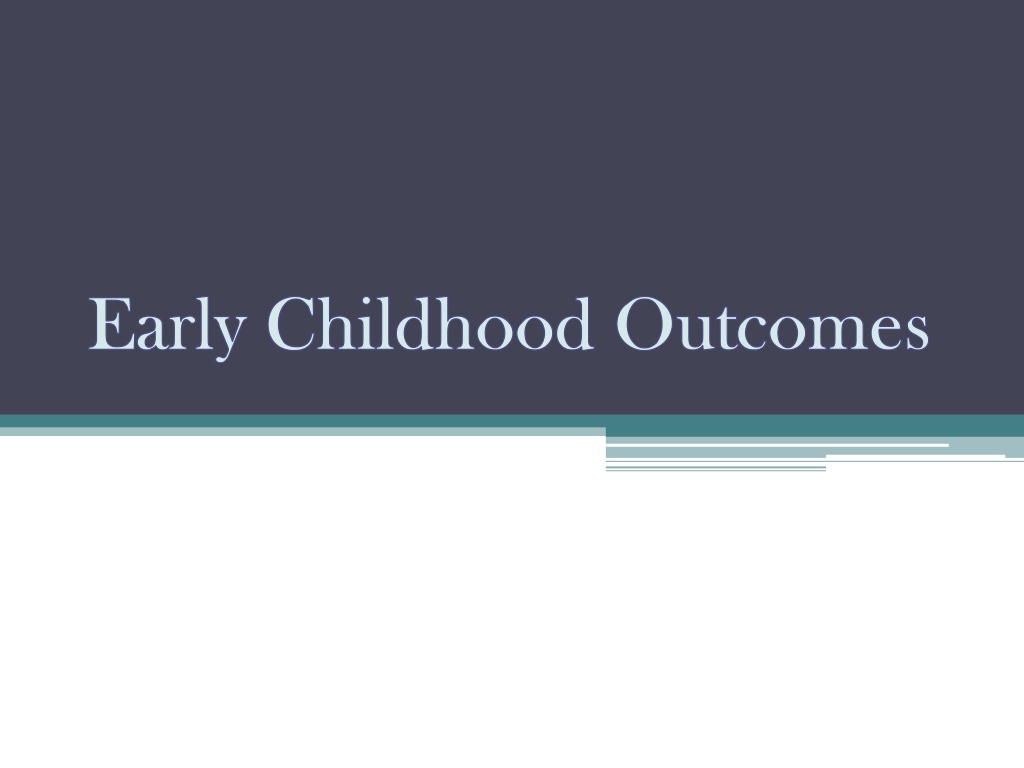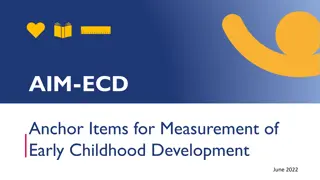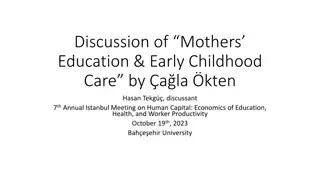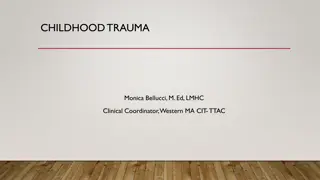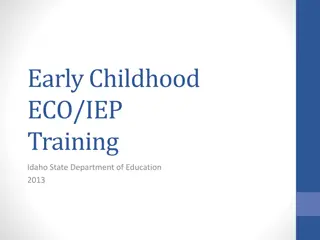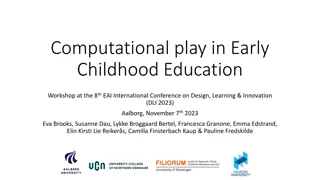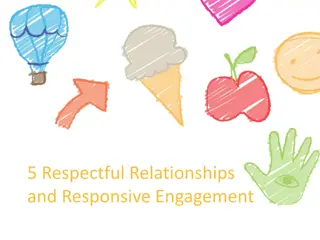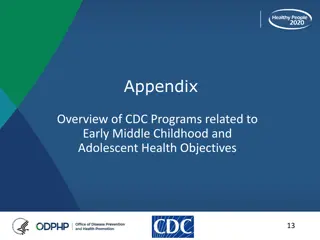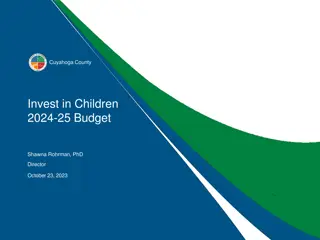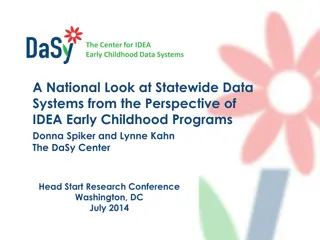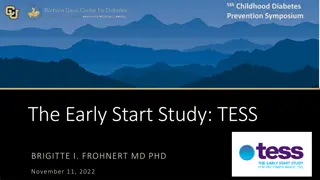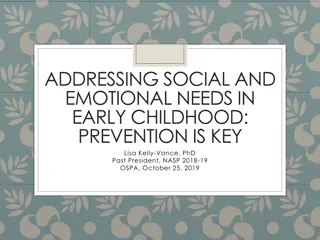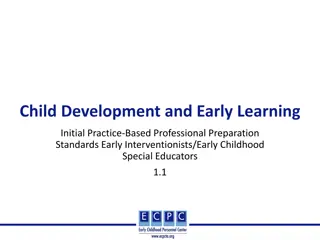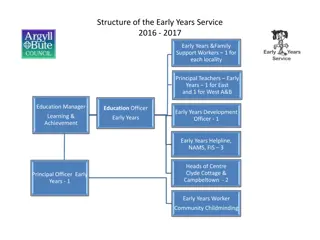Understanding Early Childhood Outcomes and COSFs
Early Childhood Outcomes (ECOs) and Childhood Outcome Summary Forms (COSFs) are essential evaluations mandated by the Office of Special Education Programs. COSFs are completed for children aged birth to six who receive special education services, focusing on social-emotional skills, knowledge acquisition, and meeting needs effectively. The assessment includes observing interactions with adults, peers, problem-solving abilities, language development, and more to track progress throughout early education programs.
Download Presentation

Please find below an Image/Link to download the presentation.
The content on the website is provided AS IS for your information and personal use only. It may not be sold, licensed, or shared on other websites without obtaining consent from the author. Download presentation by click this link. If you encounter any issues during the download, it is possible that the publisher has removed the file from their server.
E N D
Presentation Transcript
Early Childhood Outcomes Early Childhood Outcomes
What are ECOs/COSFs? Early Childhood Outcomes (ECOs) or Childhood Outcome Summary Forms (COSFs) are those required by the Office of Special Education Programs (OSEP) in Washington, D.C. to determine progress for children in preschool special education programs. You will complete these twice. Once at entry to your program and once at exit from your program. 2
COSFs Complete on all children, birth to age six, receiving early intervening or early childhood special education services. COSFs are completed based on typical child development. OK EdPlan requires only one entry and one exit rating. 3
4 Outcome Areas There are three outcome areas measured on the COSFs. All three outcomes are completed on every student. Outcome 1: Positive Social-Emotional Skills Outcome 2: Acquisition and Use of Knowledge and Skills Outcome 3: Taking Action to Meet Needs
Outcome 1 Positive Social-Emotional Skills (including social relationships) Involves: Relating with adults Relating with other children Following rules related to groups or interacting with others. Includes areas like: Attachment/separation/autonomy Expressing emotions and feelings Learning rules and expectations Social interactions and play 5
Outcome 1 Example Questions How does the student interact with teachers, parents, or other adults? How does the student interact with same aged peers in both structured and unstructured settings (playground, playgroups, etc.)? How does the student follow rules related to groups and others? How does this student handle transition (e.g. activity, places, and people)? 6
Outcome 2 Acquisition and use of knowledge and skills (including early language/communication) Involves: Thinking and reasoning Problem-solving Understanding physical and social worlds Includes: Early concepts (numbers, classification, etc.) Imitation Expressive language and communication 7
Outcome 2 Example Questions How does this student exhibit that he is able to recall previously learned information or skills? How does this student approach situations that require a solution? How does this student functionally communicate via language? How does this student use alternative means of communication? How does this student use toys and/or objects? 8
Outcome 3 Taking appropriate actions to meet needs. Involves: Taking care of basic needs Getting from place to place Using tools Includes: Integrating motor skills to complete tasks Self-help skills (e.g. dressing, feeding, etc.) Acting on the world to get what she wants 9
Outcome 3 Example Questions What basic self-help tasks can the child do for himself? How does the student move from place to place and activity to activity (either inside or outside)? How does the student recognize and utilize resources (e.g. kitchen utensils, etc.) to meet her needs? How does the student display that he is aware of his surroundings and is capable of maintaining a safe environment (understands simple safety issues and rules)? 10
11 Outcomes video Video
12 Age Expected Functioning Immediate Foundational Skills Foundational Skills
Foundational Skills The building blocks that children learn to develop subsequent, higher-level skills. Milestones we can measure that serve as indicators of the typically developing neural networks associated with maturation. 13
Immediate Foundational Skills A skill or set of skills that occur developmentally just prior to age expected functioning (e.g. full hand grabbing motion precedes pincher grasp/finger isolation). 14
Rating Scale 1-7 Based on typical child development. All three outcomes must be completed. Answer Yes or No to the question as to whether or not the child has made any progress. The majority of the time, this will be yes. Overall numbers 1-5 are not considered age- appropriate. Overall numbers 6-7 are considered age appropriate. 16
Rating Scale: 1 Child does not yet show functioning expected of a child his or her age in any situation. Child s functioning does not yet include immediate foundational skills upon which to build age-appropriate functioning. Child functioning reflects skills that developmentally come before immediate foundational skills. Child s functioning might be described as like that of a much younger child. 17
Rating Scale: 2 Child occasionally uses immediate foundational skills across settings and situations. More functioning reflects skills that are not immediate foundational. 19
Rating Scale: 3 Child does not yet show functioning expected of a child of his or her age in any situation. Child uses immediate foundational skills, most or all of the time, across settings and situations. Immediate foundational skills are the skills upon which to build age-appropriate functioning. Functioning might be described as that of a younger child. 21
Rating Scale: 4 Child shows occasional age-appropriate functioning across settings and situations. More functioning is not age-appropriate than age-appropriate. 23
Rating Scale: 5 Child shows functioning expected for his or her age some of the time and/or in some settings and situations.Child s functioning is a mix of age-appropriate and not age-appropriate behaviors and skills. Child s functioning might be described as like that of a slightly younger child. 25
Rating Scale: 6 Child s functioning generally is considered appropriate for his or her age but there are some significant concerns about the child s functioning in this outcome area. These concerns are substantial enough to suggest monitoring or possible additional support. Although age-appropriate, the child s functioning may border on not keeping pace with age expectations. 27
Rating Scale: 7 Child shows functioning expected for his or her age in all or almost all everyday situationsthat are part of the child s life. Functioning is considered appropriate for his or her age. No one has any concerns about the child s functioning in this outcome area. 29
31 Two Questions Addressed at Exit Rating Question: To what extent does the child show age-appropriate functioning, across settings and situations, on this outcome? Progress Question: Has the child shown any new skills or behaviors related to this outcomes since the last outcomes summary?
32 How to Answer the Progress Question Answer yes if the child has acquired ANY new skill related to any aspect of the outcome since the entry rating. Example: Using one new word or gesture to get his needs met. Answer no if the child has not acquired ANY new skills related to any aspect of the outcomes since the entry rating.
Skill Acquisition Over Time Skill Acquisition Over Time Answer to Progress Question is YES Answer to Progress Question is NO 10 10 9 9 8 8 7 7 Number of Skills Number of Skills 6 6 exit 5 5 4 4 3 3 entr y entr y exit 2 2 1 1 0 0 1 2 3 Age in Months 4 5 6 7 1 2 3 Age in Months 4 5 6 7
Points to Consider Answer yes if the child has acquired any new skill, even if the child has... Not made progress across all the skills in an outcome area Not moved closer to age- expected development
What Happens During the Exit COS Process? For each outcome , the team will: Gather information about the child s functioning Discuss the information and determine the rating Document the rationale for the rating Answer the progress question
Should the team look at the entry COS ratings when determining exit ratings? No! This may bias the team s determination of the exit ratings.
What if the team members who participated at the exit are different from those who participated at entry? What if...the team members who participated at the exit COS are different from those who participated at entry? 37
What if a family has left the program without notice? What if... a family has left the program without notice? 38
One Last Point on the Relationship between the Ratings and the Progress Question A rating of 4 at entry is not the same as a rating of 4 at exit. Entry Exit
40 Two Types of Growth Growth compared to what is age expected If child made any progress, but did not move on the rating scale=Growth. This should be documented on the child s IEP/IFSP.
OSEP Progress Category (a) (a): Children who did not improve functioning. Those children who acquired no new skills or regressed during their time in the program. Rated lower at exit than entry; OR Rated 1 at both entry and exit: AND score No on the progress question. 41
OSEP Progress Category: (b) (b): Children who improved functioning, but not sufficient to move nearer to functioning comparable to same aged peers. Children who acquired new skills but continued to grow at the same rate throughout their time in the program. Rated 5 or lower at entry; AND rated the same or lower at exit; AND Yes on the progress question. 42
OSEP Progress Category: (c) (c): Children who improved functioning to a level nearer to same aged peers but did not reach it. Children who acquired new skills but accelerated their rate of growth during their time in the program. They were making progress toward catching up with their same aged peers but were still functioning below age expectations when they left the program. Rated higher at exit than entry; AND Rated 5 or below at exit. 43
OSEP Progress Category: (d) (d): Children who improved functioning to reach a level comparable to same aged peers. Children who were functioning below age expectations when they entered the program but were functioning at age expectations when they left. Rated 5 or lower at entry: AND rated 6 or 7 at exit. 44
OSEP Progress Category: (e) (e): Children who maintained functioning at a level comparable to same aged peers. Children who were functioning at age expectations when they entered the program and were functioning at age expectations when they left. Rated 6 or 7 at entry; AND rated 6 or 7 at exit. 45
These categories are not ordinal (1st, 2nd, 3rd best). These categories are nominal (one is not better than another). 46
Name Entry 2a Exit 2a Exit 2b OSEP category e Maria 7 7 Yes Joseph 6 7 Yes e Jonas 3 5 Yes c Phoenix 4 4 Yes b Angela 1 1 No a Juan 2 4 Yes c Ethan 1 1 Yes b Adrian 4 5 Yes c Brittany 4 7 Yes d Landon 5 3 Yes b 47
Name Entry 2a Exit 2a Exit 2b OSEP Category Looking at our example , we see these scores are for Outcome 2: Knowledge and Skills. Entry 2a is in response to the question: to what extent does the child show age-appropriate functioning across a variety of settings and situations on thinking, reasoning, remembering, and problem solving; understanding symbols ; and understanding the physical and social worlds at entry. Exit 2b is how the child is functioning at exit. Exit 2b is a yes/no response to whether the child has made any progress. The responses to these three items yield an OSEP rating category. 48
Name Entry 2a Exit 2a Exit 2b OSEP category Angela 1 1 No a Let s consider these individually for each OSEP category. Angela entered at a 1 and exited at a 1. The answer to the progress question was no, so this placed her in the (a) category because: She did not improve functioning, and She rated 1 at both entry and exit: AND score No on the progress question. 49
Name Entry 2a Exit 2a Exit 2b OSEP Category b b Phoenix Ethan 4 1 4 1 Yes Yes Both Ethan and Phoenix entered and exited at the same number with a yes. This gives them a (b) rating because: They improved functioning, but not sufficient to move nearer to functioning comparable to same aged peers. Rated 5 or lower at entry; AND rated the same or lower at exit; AND Yes on the progress question. 50
